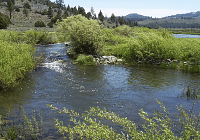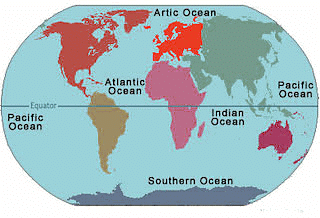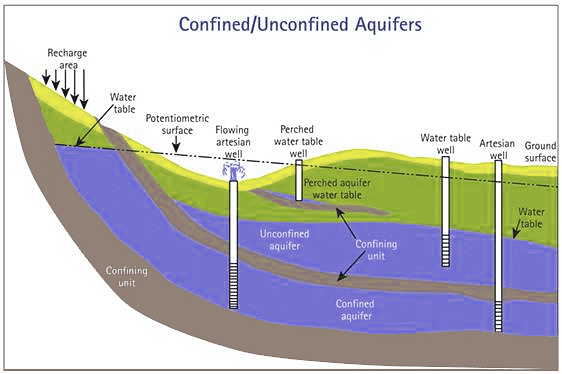Detailed Notes: Hydrological Cycle | Engineering Hydrology - Civil Engineering (CE) PDF Download
The major water reservoirs on Earth are oceans, glaciers, groundwater, rivers, and lakes. Water spends different amounts of time in the various reservoirs. The main factors that control the amount of time water stays in a reservoir are the amount of water in the reservoir and how fast water moves in and out. The hydrologic cycle (water cycle) represents a continuous global cycling of water from one reservoir to another
To understand the water cycle better, let's track a water molecule on its journey
- Starting in the ocean, the water molecule can turn into vapor and move into the atmosphere.
- The sun's heat energy causes evaporation in the oceans, changing water from liquid to gas. Evaporation is crucial for water returning to the atmosphere as vapor.
- About 90% of atmospheric moisture comes from evaporation, while the remaining 10% comes from transpiration. Transpiration is when plants carry moisture from roots to leaves, where it turns into vapor and enters the atmosphere.
- Rising air currents carry the vapor into the atmosphere, along with water from evapotranspiration, a mix of plant-transpired and soil-evaporated water.
- As the vapor rises and cools, it condenses into clouds. Condensation turns water vapor back into liquid state.
- Clouds may grow large and moist enough to release water in the form of precipitation. Precipitation is water falling from clouds as ice (snow, sleet, hail) or liquid (rain, drizzle).
- Snowfall can accumulate as ice caps and glaciers.
Did you know that the largest glacier on Earth is the Severny Island ice cap in the Russian Arctic?
- Precipitation that falls as liquid typically becomes surface flow and stream flow.
- Surface runoff refers to precipitation moving over the soil surface to the nearest stream channel.
- Stream flow indicates the water movement in a natural channel like a river.
- Most precipitation falls directly into the ocean and cyclically restarts its journey.
- Similarly, a significant portion of the water from surface runoff eventually returns to the ocean through stream flow.
- Some precipitation can enter lakes where it may evaporate into the atmosphere, condense, and fall back as precipitation.
- Water in lakes can also be absorbed by plants and released back into the atmosphere through transpiration.
- A portion of precipitation infiltrates the ground, becoming part of groundwater through the process of infiltration driven by gravity.
- Groundwater replenishes aquifers, which are reservoirs of freshwater stored in saturated subsurface rock over extended periods.
- Some infiltrated water reemerges as freshwater springs through openings in the land surface.
- Plant roots absorb groundwater, leading to evapotranspiration from the leaves.
- Over time, the water keeps circulating, with the majority eventually reaching the ocean.
Components of the Hydrologic Cycle
Most precipitation falls in the form of rain but there are other forms such as snow, hail, and sleet. Once it runs sufficiently, surface water runoff is generated when the ground is saturated or impervious. Surface water is a major component of the hydrological cycle and one that we interact with very regularly. It includes lakes, wetlands, stormwater runoff (overland flow), ponds, potholes, rivers and streams.
1. Streams and Rivers
A river forms from water moving from a higher altitude to lower altitude, under the force of gravity. When rain falls on the land, it either evaporates, seeps into the ground or becomes runoff (water running on the surface). When water runs on the land surface it usually converges as it moves towards lower elevation. The converging runoff can concentrate into single channels of conveyance called creeks, stream, or rivers. Usually these start as small rill and rivulets that would join up downhill into larger streams and creeks which can also join up downstream to form even bigger rivers. The streams and rivers that join up to form a larger river are called tributaries. The land area drained by a river and all its tributaries is called a watershed or catchment or river basin.
The area adjacent to a river that floods frequently is a called a floodplain. Floodplains are areas that rivers use to temporarily store excess water during storm events and frequently contain very fertile soils. This has historically encouraged humans to move into floodplains and use them for agriculture, resulting in a reduction in the capacity of the floodplain to act as temporally storage for excess water during storm events, causing increased damaging flooding downstream. Properly functioning floodplains reduce the negative impacts of floods (by reducing severity of flood), and they assist in filtering stormwater and protecting the water quality of rivers. They also act as areas of recharge for groundwater.
 A river with a small tributary
A river with a small tributary
The US has numerous rivers that run throughout the nation’s landscape. It is estimated that the US has over 200, 000 rivers with the Mississippi River being the largest by volume despite it only being the second longest. The Missouri River is the longest river in US. Most states have at least one important river. In Georgia, the main rivers are the Flint, Ochlockonee, Suwannee, Saint Marys, Satilla, Ogeechee, Altamaha, Oconee, Savannah, Chattahoochee, Tallapoosa, Coosa, Ocmulgee and the Tennessee rivers
These rivers are very important for supplying water to the cities and populations of the states. The rivers also contain important biological communities and provide opportunities for recreation such as swimming, fishing, and white water rafting. Rivers are so important and largely control settlement patterns all over the world. Major cities, communities, factories, industries, and power stations are located along rivers. It is, therefore, very important to protect the quality and integrity of rivers all over the world.
Many rivers worldwide are too polluted to support activities like swimming, fishing, and drinking. In the US, nearly half of the rivers are considered too polluted for swimming and fishing. Additionally, many rivers have been altered by channelization, dredging, or damming, impairing their capacity to sustain various human and ecological activities. It is estimated that over 600,000 miles of rivers in the US have been dammed. While dams offer benefits such as water supply for reservoirs and farm ponds, recreational waters, and flood reduction, they also pose negative impacts. Dams can exacerbate severe downstream flooding, especially during heavy rainfall events.
The impoundments can trap stream sediments resulting in reduced sediment supply downstream as well as increased deposition behind the dam. This shift in sediments flow can disrupt and damage aquatic habitats and can increase downstream stream erosion due to lack of sediment supply. The impoundments can also prevent certain aquatic organisms from migrating either upstream or downstream, therefore reducing their range and abilities to survive environmental changes as well cutting them off from spawning areas. Construction of dams can also result in displacement of the local people and loss of traditional lands and cultural history. Reservoirs and ponds usually form behind these impoundments.
2. Lakes, Reservoirs and ponds
If water flows to a place that is surrounded by higher land on all sides, a lake will form. A lake, pond or reservoir is a body of standing water on the land surface. When people build dams to stop rivers from flowing, the lakes that form are called reservoirs. It is estimated that over 300 million water bodies in the world are lakes, reservoirs, and ponds. Most of the Earth’s lakes (about 60%) are found in Canada. Even though lakes and rivers contain less than 1% of the Earths water, the US gets over two thirds (70%) of its water (for drinking, industry, irrigation, and hydroelectric power generation) from lakes and reservoirs. Lakes are also the cornerstone of the US’s freshwater fishing industry and are the backbone of the nation’s state tourism industries and inland water recreational activities.
3. Wetland
A wetland is a region characterized by standing water for significant portions of the year, saturated soils for much of the year, and vegetation that requires substantial water to thrive. Examples of wetlands include swamps, marshes, and bogs. Wetlands are identified by three main features: soils (water-saturated soils), hydrology (shallow water table), and vegetation (plants adapted to prolonged water saturation). Wetlands are crucial for biological diversity and productivity, as well as for ongoing geochemical and biological cycles. They play a significant role in carbon sequestration, which affects global climate change, and act as natural filters for storm-water runoff before it reaches rivers and lakes.
4. Oceans
As you have probably already guessed, oceans are an important component of the hydrologic cycle because they store majority of all water on Earth (about 95%). Most of the major rivers drain into them. The five oceans covering the surface of the Earth are the Atlantic, Indian, Pacific, Arctic and the Southern Ocean.
Approximately 90% of the water that evaporates into the hydrologic cycle originates from the ocean. Oceans play a crucial role in the hydrologic cycle and are rich in biological diversity and various landforms. The average depth of the oceans is about 3.6 km, with some areas, known as ocean trenches, exceeding depths of 10 kilometers. The ocean hosts many life forms uniquely adapted to its environment. Unfortunately, human activities such as pollution, overfishing, carbon dioxide acidification, and resource exploitation have significantly degraded the oceans and their ecosystems.

5. Groundwater
Storage and Flow
- Almost 99% of the fresh water available is located beneath the surface as groundwater.
- Groundwater is not made by mysterious processes underground but is a part of the water cycle. When rain falls, some water flows over the surface and some seeps into the ground.
- Groundwater gets refilled as water moves from the surface through rocks or sediment, eventually reaching the saturated zone through a process called infiltration, becoming groundwater.
- The top part of the saturated area is known as the water table, marking the boundary between saturated and unsaturated zones.
- Groundwater is housed in aquifers, which are rock or sediment bodies holding abundant usable water in their pores.
- Aquifer productivity is managed by porosity and permeability. Porosity signifies the open spaces in a rock or sediment, while permeability indicates how well fluids can move through the material.
- Groundwater resides in the saturated portion of a rock where all pores are filled with water. A key point to remember is that surface water moves from higher to lower elevations, while groundwater flows from higher to lower energy levels.
Groundwater will continue to flow until it emerges as a spring, or discharges into surface water bodies on the land or in the ocean. To utilize groundwater, we drill holes (wells) into the ground and pump the water out.

|
20 videos|53 docs|30 tests
|
FAQs on Detailed Notes: Hydrological Cycle - Engineering Hydrology - Civil Engineering (CE)
| 1. What is the hydrological cycle and why is it important in civil engineering? |  |
| 2. How does the hydrological cycle impact the design of drainage systems in civil engineering projects? |  |
| 3. What are the key components of the hydrological cycle that civil engineers need to consider in their projects? |  |
| 4. How can civil engineers incorporate the principles of the hydrological cycle in sustainable water management practices? |  |
| 5. What are some challenges that civil engineers face in managing water resources within the hydrological cycle? |  |
















